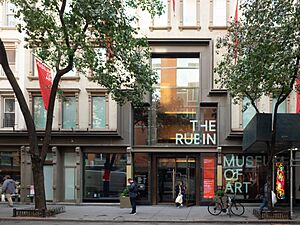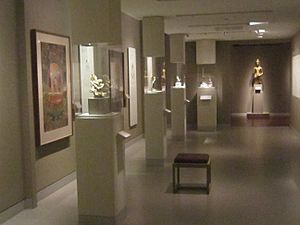Rubin Museum of Art facts for kids
 |
|

The outside of the museum as seen from 17th Street.
|
|
| Established | October 2, 2004 |
|---|---|
| Location | 150 West 17th Street Manhattan, New York City |
| Type | Art museum, education center, performance and event venue |
| Collection size | 2,000+ objects |
| Public transit access | Bus: M1, M2, M3, M7, M14A, M14D, M20, M55 PATH: JSQ-33, HOB-33 at 14th Street
|
The Rubin Museum of Art, also called the Rubin Museum, was a special museum in New York City. It was created to show and take care of art from the Himalayas and nearby areas in Asia. The Himalayas are a huge mountain range that includes Mount Everest. The museum had a special focus on Tibetan art.
The museum was located in the Chelsea neighborhood of Manhattan. It opened in 2004 but closed its building on October 6, 2024. Now, the museum has become a "museum without walls." This means it shares its art by sending it to other museums around the world and creating online resources for everyone to see.
Contents
The Museum's Story
How It All Started
The museum began with the private art collection of two people, Donald and Shelley Rubin. They started collecting art from the Himalayan region in 1974. After many years, they wanted to share their amazing collection with the public.
In 1998, the Rubins bought a building that used to be a fancy clothing store called Barneys New York. They paid $22 million for it. The building was then completely changed to become a museum. One cool feature they kept was the building's original six-story spiral staircase. This staircase became the beautiful centerpiece of the new museum.
The Rubin Museum of Art officially opened on October 2, 2004. It showed over 1,000 items, including paintings, sculptures, and special objects used in ceremonies.
A New Chapter
For many years, the museum was a popular place to visit. However, it began to face money problems. In 2019, the museum had to reduce its staff and open for fewer hours. The COVID-19 pandemic also made things more difficult.
Because of these challenges, the museum leaders made a big decision. They announced that the museum's building in New York City would close in October 2024. Instead of having one physical location, the Rubin Museum now works as a global museum. It lends its art to other places and continues to support the study of Himalayan art all over the world.
The Museum Building
The museum was in a large building that was once a Barneys department store. The building was transformed into a six-floor art space. Many of the original details were kept, like the famous steel-and-marble spiral staircase that twisted up through the center of the galleries.
Besides the galleries for art, the museum had a photo gallery, a studio for making art, and a theater for shows and events. There was also a café and a gift shop. In 2011, the museum opened a new Education Center next door, which was a large space for learning activities.
What Was on Display?
The Rubin Museum was known for its fascinating exhibitions that connected art with ideas about life and culture.
Some of the first exhibitions had interesting names like "Methods of Transcendence" and "The Demonic Divine in Himalayan Art." These shows explored spiritual ideas from the Himalayan region.
One special exhibition in 2013 was a photography project by Lisa Ross called Living Shrines of Uyghur China. It showed pictures of holy places important to the Uyghur people in China. The photos were about keeping culture and spirit alive.
The Mandala Lab
In 2021, the museum opened a unique permanent installation called the Mandala Lab. A mandala is a spiritual symbol in Hinduism and Buddhism that represents the universe. The lab was a special place designed to help visitors learn about and manage their emotions. It used ideas from Buddhist art to create fun, interactive experiences that taught about emotional wellness.
Gallery
See also





